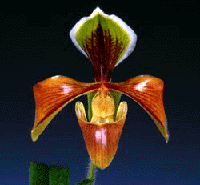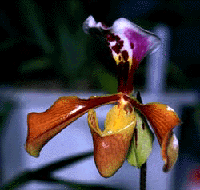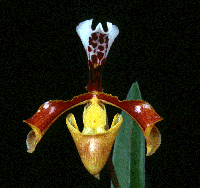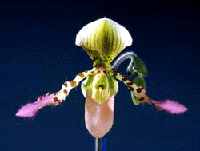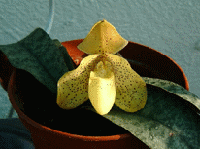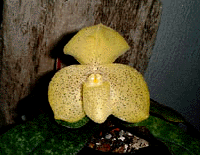皆さんによる意見・希望・質問コーナー
Question & Answer Corner
とうや さん 000407
e-mail : gratrixianum@mail.goo.ne.jp
Q:はじめまして、とうやと言います。25歳です。パフィオを専門に栽培をはじめて4年目になります。質問をさせていただきます。一昨年、とある公園の洋ラン展示会で下記の2種類のパフィオを購入しました。
1. Paph. gratrixianum
2. Paph. Rodney Wilcox Joans
1は小文字で始まっているため、原種でしょうか?
できれば、栽培方法をお教え願います。2は交配種であることは容易に想像できます。が、展示品の即売であったためラベルが下に落ちてしまっていたため、ラベルと株があっているかもアヤシイです。いろいろ図鑑などを調べましたが、この品種名じたい見つかりません。株は大型で、葉の長さは30cmほどです。一茎多花で、順に花を咲かせるタイプです。ヘンリエッタ・フジワラに似ているように思います。誠に勝手ながら、お教えください。
A:
まず、1について。そのとおり、これは原種です。この種に類似した原種は3種類ありますので、まず、これらを紹介しましょう。一言で言えば、ビロッサムとその仲間達と言えます。
ビロッサムの変種には、かつては異種として扱われていたボクサリー(Paph. boxalii)とオーレウム変異種のアナメンセ(Paph. annamense)があります。ボクサリーは、今では学術的にはビロッサムの変種とされていますが、RHSでは園芸的に古くから区別されていることから、今でもボクサリーを独立させて登録に用いられています。ここでは、説明の趣旨に反しますので、アナメンセは一応除外してください。一方、これらの原種とよく似ていますが、グラトリキシアナム( Paph. gratrixianum )は1987年にクリブ(Cribb)により報告された品種であり、上記の原種とは別種とされています。ビロッサムは中国南部、ベトナム、ラオス、タイ、ミャンマー、インドの北部からアッサム地方に至るまで、海抜1200〜2000メートルの東南アジアの中北部に広く分布している。一方、後者はラオスとベトナムの中部から北部に広く分布しています。かつては希少種とされましたが、普通種であることは間違いありません。
Paph. villosum
Paph. boxalii
Paph. gratrixianum
Paph. gratrixianum
グラトキシアナムの栽培は原種の中でも比較的容易に栽培できる品種です。コンポストは水苔でも杉皮でもよく、また、ミックスコンポストでもとてもよく栽培できます。水は好む方で、特に早春から夏には十分に与えるようにし、冬でも決して乾燥させないようにします。光は好む方ですが、比較的弱くても順調な生育を示し、花も付けます。できれば、夏は50〜60%、冬でも40〜50%の遮光がよいでしょう。肥料も好む方で、生育期には肥料切らさないようにすると、新しい芽をたくさん出して一挙に大株にすることができます。大株を楽しむには最適な品種と言えます。滞った空気は好まないので、風通しには十分に気をつけましょう。水は決して枯らさないようにし、規定より更に4〜5倍希釈した薄い液肥を頻繁に与えるとよいでしょう。
次に Paph. Rodney Wilcox Joans についての説明です。
Paph. Rodney Wilcox Joans は hynaldianum と glaucophyllum との交配ですが、JoansではなくJonesです。もう一度、正しくは、Paph. Rodney Wilcox Jones です。栽培はとても容易な交配種と言えます。少し温度を高めにすると、驚くほど良い生育を見せると思われます。ヘンリエッタ・フジワラはハイナルディアナムとプリムリナムとの交配ですから、ロドニー・ウィルコックス・ジョーンズとは共に交配相手にコクロペタラムを用いたものです。従って、株の姿はとてもよく似ていると思われます。でも、コクロペタラムの中でもプリムリナムの花は特異(ふつう黄色の色素しか持たない)なので、花はこれ(交配相手にプリムリナムを用いたもの)だけが大きく異なります。その他の原種を交配相手にすると、多少の違いはありますが、原則的にとても類似した花になるでしょう。
花は写真のように、コクロペタラムの影響を強く受けた形態を示すようです。全体的には淡い色彩で、ほのぼのとしたとても優しさのある上品な花を咲かせます。花が咲いたら、是非写真を送って下さいね。 Paph. Rodney Wilcox Jones
Miss. Leung Chun Hong Kong 000311
e-mail : June_Leung@ismbci.com.hk
Q:Hi Toshi ,
(1) I have one question about Paph., I brought a Paph. philippinense few months ago, the plant has not been flower before, however, it already reach the mature stage. Yesterday, my brought help me brought 2 more Paph. philippinense. (LOL) When the plant arrived, I found they much greener than the one I have, I think my one was green as this new one, for some reason when it get into my green house, the leaves start to turn yellowish - green, I have a fan constantly gives air movement inside my green house, but what case the Paph. leaves turn into yellowish? If I can have recommendation from you, I think I can take more good care of that plant, Thanks thanks ^_^
(2) I currently have few Paph. concolor, last year, they have their first flower, the inflorescence was 4 cm to 4.5 cm long, carry 2 light yellow flowers (I almost think is yellowish - white), with tiny red dots. The flower was about 3 cm to 3.5 cm across, that was very cute. This year, 2 of them flower again, this time, one has 2 inflorescence, very short about 2.5 cm long, one carry 1 flower, other carry 2 flowers. The single flower inflor. open first, has bigger flower than last year, 4 cm across, with much darker yellow, almost like egg yoke yellow, with darker and bigger red dots. The 2 inflor. make the plant look very crampy with such short inflor. (See Photo1 ) Other Paph. concolor, this one has about 3 cm inflor. carry one HUGE flower, about 4.5 to 5 cm across, very dark yellow, red dots. (See Photo 2 ) I can guess why the flower bigger than last year, could be this is the second flower, or could be because I add some self make fertilizer (boon powder + small amount of egg + flour = dry it becomes hard), I place it on the top of the growing medium. But why the inflorescence become so short this year? Please give me some advice. Regards,
June
Photo 1
Photo 2
A:(1) I guess, it dependent on the difference on their environment like temperature, humidity, the strength ad quality of sun light and watering etc. The minute difference of them will change the difference of plant's growing including the color of leaves. Turning to yellow means the pigments of chloroplast have changed. In truth , which situation make the leaves' color to be changed by. But I guess it dependent on Sun light. There are bigger difference between natural condition and our artificial condition imaged. Of course, air movements they need. But cool and more moistured wind they need, I guess. If you want to grow in much better condition, you have to try in various condition using shade, making better fan etc. I can not advice in detail because our environment is so big differ each other. Please try and find out your best condition for Paph. philippinense by your self.
(2) The results is similar as above. The flower of Paphs are different from the previous one from the same plants. Although the heredity of plant is not changed, the flower will change every time. It dependent on the physical situation of plants. Its dependent on the environment that the plant is growing up. Of course, fertilizer is contained in this condition. From the minor difference, the flower will be changed. The shape, color, spots, flowers number and the length of influorescence of flower will be changed. After breeding or after transferring the plant, the flower will be changed. Under the best condition that the plant has its strongest power, the flower is so nice. And it dependent on the species. For example, the best specimen is Paph. sukhakulii. If the flower is awarded with 3.0 cm of petal width, the flower will be very poor that we want to throw out with 2.0 cm petal sometimes. So the advice must be same. We have to find the best way for your self in your own condition and grow them in the best situation. Thank you. Toshi
